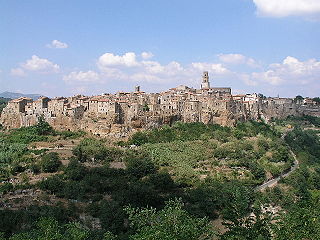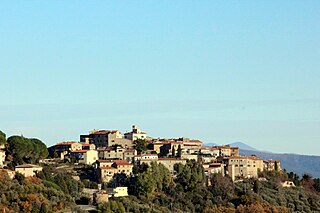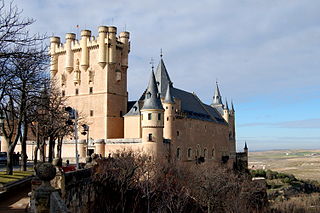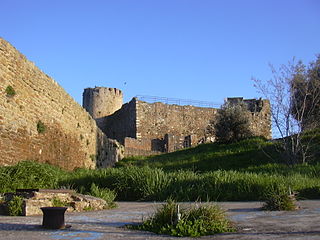
Pitigliano is a town in the province of Grosseto, located about 80 kilometres (50 mi) south-east of the city of Grosseto, Tuscany Italy.

Sovana is a small town in southern Tuscany, Italy, a frazione of Sorano, a comune in the province of Grosseto.

Istia d'Ombrone is a small town in southern Tuscany, Italy, a frazione of the comune of Grosseto.

Giuncarico is a village in Tuscany, central Italy, administratively a frazione of the comune of Gavorrano, province of Grosseto. At the time of the 2001 census its population amounted to 399.

The Vie Cave, also known in Italian as Cavoni, is an impressive road network in southern Europe, found in Spain, Italy, Turkey and as far east as Jordan. In Italy they partly link an Etruscan necropolis and several settlements in the area between Sovana, Sorano and Pitigliano. They consist mainly of trenches of variable width and length, excavated as nearly vertical cliffs in different types of bedrock, sometimes over sixty feet high, possibly serving as a defense system against invaders, wild animals or forces of nature. Although often dated as being carved by pre-Roman civilisations in the first or second millennium BC, the builders and purpose of the road system are largely unclear, and there are indications that they are much older than assumed.

Tatti is a village in Tuscany, central Italy, administratively a frazione of the comune of Massa Marittima, province of Grosseto, in the area of the Colline Metallifere. At the time of the 2001 census its population amounted to 231.

Buriano is a village in Tuscany, central Italy, administratively a frazione of the comune of Castiglione della Pescaia, province of Grosseto. At the time of the 2001 census its population amounted to 257.

Castell'Ottieri is a village in Tuscany, central Italy, administratively a frazione of the comune of Sorano, province of Grosseto, in the tuff area of southern Maremma. At the time of the 2001 census its population amounted to 195.

Catabbio is a village in Tuscany, central Italy, administratively a frazione of the comune of Semproniano, province of Grosseto. At the time of the 2001 census its population amounted to 203.

Elmo is a village in Tuscany, central Italy, administratively a frazione of the comune of Sorano, province of Grosseto, in the tuff area of southern Maremma. At the time of the 2001 census its population amounted to 44.

Marsiliana, known also as Marsiliana d'Albegna, is a village in Tuscany, central Italy, administratively a frazione of the comune of Manciano, province of Grosseto. At the time of the 2001 census its population amounted to 246.

Montebuono is a village in Tuscany, central Italy, administratively a frazione of the comune of Sorano, province of Grosseto, in the tuff area of southern Maremma. At the time of the 2001 census its population amounted to 37.

Montemerano is a village in Tuscany, central Italy, administratively a frazione of the comune of Manciano, province of Grosseto. At the time of the 2001 census its population amounted to 438.

Montevitozzo is a village in Tuscany, central Italy, administratively a frazione of the comune of Sorano, province of Grosseto, in the tuff area of southern Maremma. At the time of the 2001 census its population amounted to 106.

Montorio is a village in Tuscany, central Italy, administratively a frazione of the comune of Sorano, province of Grosseto, in the tuff area of southern Maremma.

Rocchette di Fazio is a village in Tuscany, central Italy, administratively a frazione of the comune of Semproniano, province of Grosseto. At the time of the 2001 census its population amounted to 19.

Sasso d'Ombrone is a village in Tuscany, central Italy, administratively a frazione of the comune of Cinigiano, province of Grosseto. At the time of the 2001 census its population amounted to 300.

San Valentino is a village in Tuscany, central Italy, administratively a frazione of the comune of Sorano, province of Grosseto, in the tuff area of southern Maremma. At the time of the 2001 census its population was 58.































